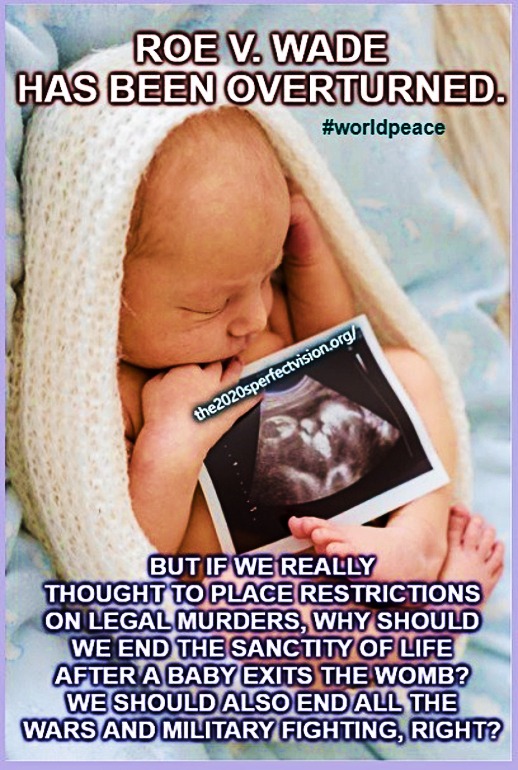This world is oft fraught with much fear and painted illusions.
We are, however, commanded (or at least impelled) by the sanctity of life to restrict doing harm to any lifeforms, and after the End of the Correction, we can be more real with life instead of playing along with all the malarkey and shenanigans of a fallen nature such as war, the use of the military, police shootings, capital punishment, thievery, subjugation, etc., etc.! I hope so at least. Better yet….. you know I have a lot to say there, so never mind.
About life imprisonment for mothers who intentionally kill their offspring, well… if the premise here remains the same, then there will not be any more of that nonsense. The same criteria would go for what mistakes may have happened in the past. We must then assume that we had no free will, and that, whatever it was, it was bound to have happened eventually, anyway. We find it actually needed to happen. The point of this post should be the sanctity of life, anyhow, aye.
As we have already seen, many secular philosophies have undermined the right to life. Beginning in the Enlightenment, this has had a profound impact on debates surrounding the value of human life. The first major debate over these issues to erupt during the Enlightenment was about the morality of suicide. Before the Enlightenment suicide was almost universally rejected in Western culture.
However, during the Enlightenment, some thinkers, such as the famous British philosopher David Hume, argued that suicide was permissible. In his essay, “On Suicide,” which was published posthumously in 1777, Hume divulged the dehumanizing thrust of his philosophy, when he stated, “But the life of a man is of no greater importance to the universe than that of an oyster.” Suicide, then, is no big deal.
In the late nineteenth century, a new debate about the value of human life emerged when some began arguing for euthanasia. The term euthanasia, which literally means “good death,” had previously meant trying to relieve pain and suffering for those nearing death. However, the term was redefined in the late nineteenth century by a new movement that favored taking active measures to end the lives of those who were either suffering or disabled. While many early euthanasia proponents supported assisted suicide or voluntary euthanasia, some began supporting killing disabled infants and sometimes adults. Nazi Germany became the most radical promoter of euthanasia, when, under the cover of World War II, Hitler introduced a program to kill people with disabilities. The Nazi euthanasia program killed over 200,000 disabled Germans and untold thousands more in Nazi-occupied territories.
In the twentieth century, abortion became one of the hottest controversies relating to the right to life. At the beginning of the century abortion was almost universally outlawed, but over the course of time, especially during the so-called Sexual Revolution of the 1960s and 1970s-this changed, and by the end of the century, abortion was legal in most countries of the world.
However, we should find that only by fully understanding ourselves and our relationship to and with other humans can we adequately regulate people’s rights and obligations to one another. Due to its inheritable nature, gene editing, amongst other advanced scientific developments, will have an impact on the intergenerational relationship between people. The evolution of the concept of the sanctity of human life to the universally accepted concept of ‘dignity’ has now been entrenched in numerous international regulatory instruments to protect this and other human rights which provides a backdrop and context in which gene editing and other advanced therapies must be judged having regard to its effect on future generations. Science accepts that humans can only be fully understood by investigating all the aspects of a human being that consist of physical, psychological, and intellectual aspects. Although the vulnerability of human life and dignity was tragically exploited during the Second World War, the protection of the sanctity of human life, in the form of dignity, has since been universally formalized in many declarations, national constitutions, and case law.
Courts can now enforce these rights and order protective steps against violations thereof. Sanctity of human life and dignity has come a long way, but further evolution and protection thereof is needed to also protect future generations that will suffer and/or enjoy the results of, or even be the products of scientific and medical advancements to ensure a society in which human rights are still valued.
References
__Botes, M. (2020). Sanctity of the human genome as foundation of life. Medical Research Archives, 8(9).
__Weikart, R. (2017). Upholding the Sanctity of Life in a Culture of Death. Issues in Law & Medicine, 32, 269.

